| ¡@J-PARC News - March 2013 (Issue #96) |
| At the pulsed neutron source of MLF, measures were taken in November of last year to mitigate the impact on the mercury target vessel due to injection of the proton beam, and since then trial operation at an output of 300 kW has moved into full swing. Recently, it was confirmed using the special neutron measurement instrument NOBORU (NeutrOn Beamline for Observation and Research Use) in BL10 that an intensity of about 65 trillion neutrons per pulse has been obtained, thereby confirming that this is the world's highest intensity pulsed neutron source. |
  |
 * Click here to enlarge. * Click here to enlarge. |
 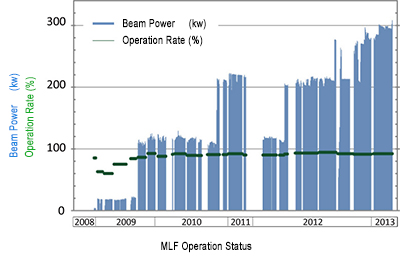 |
 * Click here to enlarge. * Click here to enlarge. |
|
| Latest Results on the µ-neutrino Deficit Phenomenon in the T2K Experiment |
| In the Tokai to Kamioka (T2K) long-baseline neutrino oscillation experiment, a high-intensity neutrino beam produced in the J-PARC Neutrino Experimental Facility is directed into the neutrino observation unit (Super Kamiokande) of the Institute for Cosmic Ray Research, the University of Tokyo, located 295 km away. The masses and mixing of the 3 types (generations) of neutrinos are investigated in detail using the approximately 11,000 Poto multipliers of the Super Kamiokande. If the three generations of neutrinos have weight, and there is mixing between generations, then a phenomenon will occur whereby one type of neutrino changes (oscillates) into another type of neutrino. In 2011 we reported that possible events of this phenomenon were observed in the T2K experiment, for the first time in the world, wherein it is thought that a µ-neutrino changed (oscillated) into an electron neutrino, and this was major news. (It was announced to the press on June 15, 2011.) As a result of examining data obtained in the period up to summer 2012, an extremely important result was recently achieved regarding the µ-neutrino deficit phenomenon, in which the number of µ-neutrinos which should be observed decreases because µ-neutrinos change into τ-neutrinos. Based on the reduction percentage and oscillation pattern, analysis was conducted of the difference of squares of mass, which is a parameter describing oscillation between the second and third generation of neutrinos, and the value of angle θ23 indicating the degree of that mixing. When this was done, it was found that the mixture angle θ23 was determined at the highest precision in the world, greater than in results due to the MINOS experiment conducted in USA, and results due to the atmospheric neutrino experiment which is in progress at Super Kamiokande in Japan. This result was reported at international workshops, firstly at Lake Louise Winter Institute (February) , and subsequently at Neutrino Telescopes (March) . The result is attracting attention from researchers throughout the world. At present θ23 has the lowest precision of mixing angles between the 3 types of neutrino generations. Our recent result is a major advance, and going forward it should clarify the overall picture of the mass and mixture of the 3 generations of neutrinos, and help establish basic concepts for elementary particles (CP asymmetry) .
The T2K experiment is a joint international experiment, and over 500 researchers from 12 countries throughout the world are participating. From Japan, a total of about 80 researchers and students - from the High Energy Accelerator Research Organization, Institute for Cosmic Ray Research (the University of Tokyo) , Osaka City University, Kyoto University, Kobe University, the University of Tokyo, and Miyagi University of Education - are participating as core members of the experiment. |
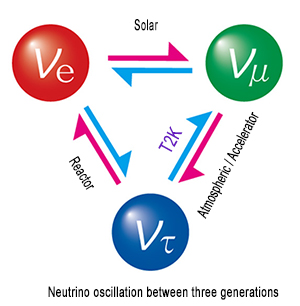 |
 * Click here to enlarge. * Click here to enlarge. |
 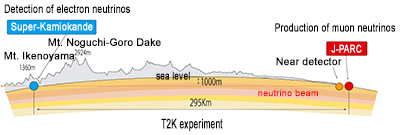 |
 * Click here to enlarge. * Click here to enlarge. |
| £to Page Top |
|
| The 2nd J-PARC Colloquium - Translational Research with Neutrons and X-rays - |
| The 2nd J-PARC Colloquium was held at the Ibaraki Quantum Beam Research Center (IQBRC) on February 27th, 2013. The speaker was Dr. John W. White, Professor of the Australian National University and Fellow of the Royal Society of London and the Australian Academy of Science. He is an internationally recognized leading scientist particularly in the development and application of novel techniques using neutron and X-ray scattering. He also has an intimate involvement with the J-PARC project as a chair of the J-PARC International Advisory Committee since the construction stage. His talk covered a wide range of scientific topics from the history of the scientific advance, researchers' passions, to the importance of instrumental development. In the talk, he repeatedly talked about his expectation for the future science at J-PARC with the worldfs strongest pulsed neutron source. Therefore, for the J-PARC staff his talk was not just interesting but also stimulating. |
 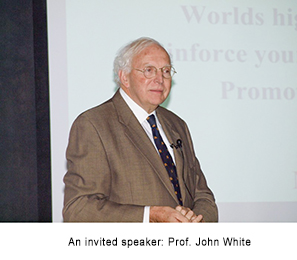  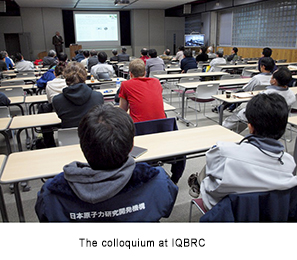 |
 * Click here to enlarge. * Click here to enlarge. * Click here to enlarge. * Click here to enlarge. |
| £to Page Top |
|
| Workshop on "Multi-purpose Use of the J-PARC Accelerator-driven Transmutation Experimental Facility" |
| J-PARC plans to build the Accelerator-Driven System (ADS) Experimental Facility as the second phase of the J-PARC project. On March 18, 2013 the workshop was launched by Yujiro Ikeda (Director, J-PARC Center) , who explained the main purpose of the gathering. He was followed people affiliated with ADS, who reported on the purpose and nature of their research, and provided an overview of the facility. An experimental facility for multi-purpose use is being considered, which will enable branched use of the proton beam from the accelerator injected into nuclear spallation targets relating to ADS, and use of neutron beams from the nuclear spallation targets. Four projected uses of this facility were presented by users. At the end of the workshop, a lively discussion was held by these presenters, moderated by Professor Satoru Yamashita of the University of Tokyo, on the topic "The Need for Multi-purpose Use of Quantum Beams" and the participants discussed the best approach for achieving multi-purpose use of facilities. The attendees agreed to establish a user committee, and will work to identify needs and expand the number of users. |
 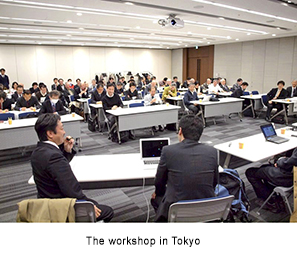  |
 * Click here to enlarge. * Click here to enlarge. * Click here to enlarge. * Click here to enlarge. |
| £to Page Top |
|
| Facility updates |
| A filament break during operation significantly affects the facility availability and decreases operation time for users. Therefore, we usually replace a filament at the end of each operation cycle, i.e. "Run". A recent close study of current changing patterns of filaments allows us to estimate a lifetime of a filament and consequently to reduce the replacing time of a filament. Additionally a test bench for R&D of a new Radio Frequency Quadrupole (RFQ) fro a high current beam is prepared in the Linac building for the future 1MW operation at J-PARC. At the Materials and Life Science Experimental Facility (MLF) , a spare neutron reflector for the target assembly is planned to prepare in the period of 2013-2015. Recently the construction of beryllium blocks for the reflector has been completed in Kazakhstan. At Hadron Experimental Facility, work is progress for laying rails to move the Superconducting Kaon Spectrometer (SKS) electromagnet from K1.8 experimental area in the north to the south hall. Work for installing a Frequency Modulation (FM) cyclotron electromagnet at the new K1.1 beam line is also ongoing in the south hall. At Neutrino Experimental Facility, the second electromagnetic horn is planned to be replaced this summer. The spare horn for the replacement produced at University of Colorado arrived at KEK in February. On-line operation tests will be conducted hereafter. |
 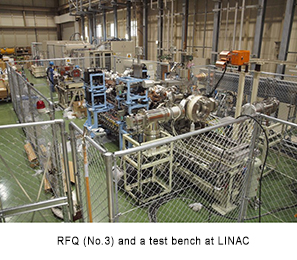 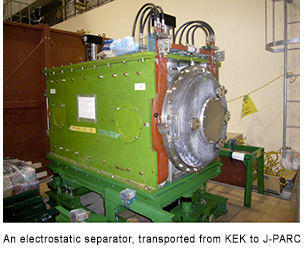 |
 * Click here to enlarge. * Click here to enlarge. * Click here to enlarge. * Click here to enlarge. |
 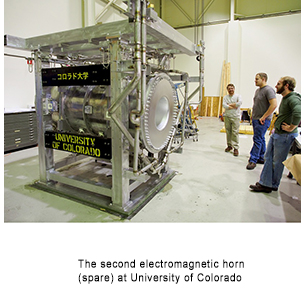 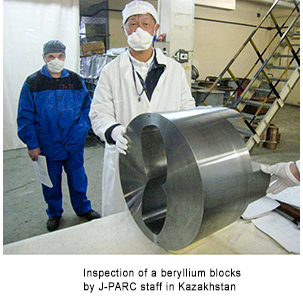 |
 * Click here to enlarge. * Click here to enlarge. * Click here to enlarge. * Click here to enlarge. |
| £to Page Top |
|
Copyright 2011 JAEA and KEK Joint Project. All rights reserved.
|
|